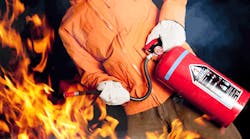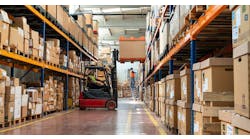All it takes is the combination of all three elements of the "Fire Triangle" to destroy a business in a few minutes. It often starts in the warehouse. Just mix oxygen, a fuel source and a heat source.
Case in point: a 35,000 square-foot Texas warehouse was crippled in August 2012 after stacks of plastic pallets burned for six hours. By the time more than 120 firefighters extinguished the blaze, $9 million in damage was done. A report from the local fire department noted the pallets reached 18 feet high, a fire code violation, and that sprinkler valves were turned off.
According to the National Fire Protection Association, more than 114,000 non-home structure fires occurred in the United States in 2011. The fires caused $2.8 billion in property damage, injuries, devastation to companies' bottom lines and—in the most severe cases—death. Fire code violations can contribute to the extent of the damage. To limit the risk of destruction caused by fires, it is important to consider several things in order to fireproof a warehouse.
Choose the Right Equipment
Ensuring your building has the necessary fire protection equipment is crucial. This includes fire extinguishers, sprinkler systems, alarm systems, emergency lights and exit signs. Equipment must also be properly maintained in order to remain compliant with NFPA codes and to best protect your facility and employees. Enlist the help of a licensed and certified fire protection service provider to complete inspections, safety tests and repairs for the following:
Fire Extinguishers
Regulations from the Occupational Safety and Health Administration (OSHA) and NFPA require functioning, portable fire extinguishers. These must be properly located, easily accessible, fully charged and ready for immediate use. Units also need to be maintained, inspected and retagged annually.
A licensed fire protection service provider can conduct thorough examinations and handle repairs, recharging or replacement. This involves ensuring the units are not blocked, the pressure is at the recommended level and no dents or chemical deposits are visible. They will also confirm your facility has the right type of extinguisher(s) for the most likely fire hazard (see "The ABCs of Fire Extinguishers" sidebar). Lastly, fire protection service providers document fire extinguisher data so you can easily demonstrate compliance with national, state and local requirements.
Emergency Lights and Exit Signs
During a fire, visibility may be limited by power failure or thick smoke, making it difficult for employees to safely evacuate. To reduce panic and confusion, place proper emergency lighting and exit signs throughout the facility. These enable safe and timely evacuation by visually lighting the way.
The NFPA Life Safety Code requires a monthly inspection of emergency lighting to ensure its functionality in case of a fire. Additionally, all occupied buildings must have exit signs that are brightly lit and visible from all directions. In addition to the monthly inspections, NFPA Life Safety code also requires an annual inspection. During this annual inspection, exit light batteries should undergo a burn test which simulates lighting the unit for 90-minutes solely using back-up power. Upon passing, your fire protection service provider will tag each unit as passed and properly functioning.
Sprinkler Systems
Automatic sprinkler systems could have reduced the extent of damage in the Texas warehouse had they been turned on and functioning. Think of a sprinkler system as your lowest cost employee; it is there 24/7, always on duty to help extinguish a fire automatically and report an alarm condition to the fire department. A well-maintained sprinkler system can help slow down a fire's progress until emergency personnel arrive.
Install, test and maintain sprinkler systems with the help of a fire protection service provider to remain compliant and guarantee the water supply is operable, sprinklers are free from obstructions and systems are fully functional. Research shows that the main reasons sprinkler systems fail are lack of maintenance and the system being manually or accidentally shut off. Due to the complex nature of sprinkler systems the NFPA Life Safety code requires systems to be inspected quarterly.
Alarm Systems
An important step for fire safety involves early detection and warning to building occupants before the situation becomes critical. Data shows that a fire can double in size and intensity every 30 seconds, and having a fully functional fire alarm system can literally be the difference between life and death. When smoke, heat or fire is detected, alarm systems send a corresponding notification to a central dispatching station or nearby fire department to dispatch the first responders. These systems simultaneously trigger visual cues such as intense sound effects and flashing lights to help signal a fire to building occupants.
Alarm systems and panels are complex electrical devices with many inputs and outputs that need to be inspected and maintained every six months for functionality and NFPA compliance purposes. Like many of the fire life safety devices above, partnering with a licensed fire protection provider can ensure your alarm and all its components are completely functional.
Training Your Employees
Purchasing and maintaining the proper emergency response equipment is only half of the fire safety equation. To truly fireproof a facility, fire safety should begin and end with training that emphasizes prevention and protection. Be sure employee training sessions cover:
The role of the fire emergency response team
A fire emergency response team is a group of individuals who are willing to enforce fire safety throughout your facility. These people will also take an active role in helping others evacuate during a fire. Ask for volunteers to join this team and encourage them to point out fire hazards to employees in a friendly manner.
Fire prevention plans
Important fire prevention tips include properly handling chemicals that may be flammable or ignite when mixed, smoking only in designated areas, reporting electrical hazards and helping to maintain building security to prevent arson fires. These tips can remind workers to stay alert for risks and practice safe behaviors. Outline rules and procedures in a fire prevention plan and review it during regular safety training sessions. The plan will also document who is responsible for identifying fire hazards. Each building is unique, so ensure fire prevention plans are customized and meet the specific needs of the business.
How to use a fire extinguisher
On an annual basis, OSHA and NFPA require fire extinguisher training for employees. Every employee should receive required training and be briefed on new or updated regulations. Consider offering on-site training using a simulated fire to give employees hands-on training with equipment.
Fire emergency evacuation
If employees know what to do and where to go during a fire emergency, it is less likely they will experience fear and confusion. Establish a detailed evacuation plan that outlines how and when to respond, and identifies primary and alternative exit routes. Communicate the plan to workers and post copies of the evacuation routes in bathroom stalls and break rooms as well as near all exits. Update it should your building undergo any structural changes, such as new additions.
Covering All the Bases
Safeguarding valuable goods is an essential goal of every warehouse. However, a fire can quickly wreak havoc on a building's contents, especially if fire code violations exist or workers are not trained. Fireproofing a facility better protects your business' bottom line and safeguards workers. With the help of a fire protection service provider, you can ensure your building has the right equipment in place, the necessary preventative maintenance has been performed and your business is compliant with NFPA codes. Lastly, a training provider can assist with employee preparation so your workforce is cautious of fire hazards and will respond appropriately in emergency situations. With this complete approach to fire safety, it's possible the "Fire Triangle" will not make your warehouse its home.
John Rudy is fire protection marketing manager at Cintas Corporation.



